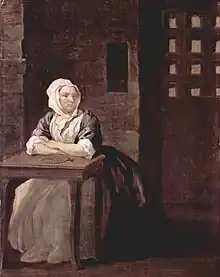Sarah Malcolm | |
|---|---|
 Hogarth's sketch | |
| Born | c. 1710 |
| Died | early March 1733 (age about 22) London, Great Britain |
| Cause of death | Hanged |
| Nationality | British |
| Known for | killing three women |
Sarah Malcolm (c. 1710 – early March 1733) was a British murderer who was sketched by William Hogarth as she awaited execution for a multiple murder.
Life
Malcolm came from an Anglo–Irish family in County Durham, where she was born around 1710.[1] She was brought up in Dublin. She came to London and found work in domestic service, working as a laundress for residents above the Inns of the Court.[1] She came to know an old lady named Lydia Duncomb (aged about 80). Duncomb lived with two maids: Elizabeth Harrison (aged about 60), who was infirm; and Ann Price (aged about 17).[2] In February 1733 the three women were found murdered and their apartment burgled, and Malcolm was brought in for questioning.
Malcolm confessed to being involved in the robbery (itself a capital crime), but said that she was part of a group of four. If she could have implicated the other three for the murders then she might still have escaped a death sentence, but the investigators were not convinced. The key evidence was that her clothing had blood stains (Malcolm claimed this was simply her own menstrual blood rather than the blood of the victims[2][3]) and that 45 guineas were found hidden in her hair. During the trial she defended herself, and Jane Magreth considers that her defence was "convincing" and "at least worthy of consideration".[3] Arthur Griffiths, military historian, author and prison administrator states that she was an "unsexed desparado", her murders of "particular atrocity even in those bloodthirsty times".[4] Malcolm was sentenced to be hanged after the jury took 15 minutes to decide her guilt.[5] Hanged at Tyburn in London in early March 1733, still denying the killing, she is remembered because William Hogarth visited her in Newgate Prison a few days before she was executed and sketched her and later arranged for both an engraving and later an oil painting to be made of her.[6][1] Hogarth was not alone in exploiting her notoriety as others went to see if they could gain a confession that they could publish.[7]
References
- 1 2 3 "Sarah Malcolm, laundress turned murderess". www.thegazette.co.uk. Retrieved 22 April 2020.
- 1 2 "February 1733, trial of Sarah Malcolm, alias Mallcombe (t17330221-52)". Old Bailey Proceedings Online. 1733. Retrieved 30 March 2019.
- 1 2 Magrath, Jane (1 July 2004). "(mis)reading the bloody body: the case of sarah malcolm". Women's Writing. 11 (2): 223–236. doi:10.1080/09699080400200306. ISSN 0969-9082.
- ↑ Griffiths, Arthur (1884), The chronicles of Newgate, Section 14 Later Records Part 1
- ↑ Ian Donnachie, ‘Malcolm, Sarah (c.1710–1733)’, Oxford Dictionary of National Biography, Oxford University Press, 2004 accessed 7 Aug 2014
- ↑ Sarah Malcolm, YourPaintings, BBC, retrieved 7 August 2014
- ↑ Sarah Malcolm, The Tate, retrieved 7 August 2014
External links
- Old Bailey Proceedings Online, Trial of Sarah Malcolm. (t17330221-52, 21 February 1733).